Related Research Articles

Alameda is a city in Alameda County, California, United States, located in the East Bay region of the Bay Area. The city is built on an informal archipelago in San Francisco Bay, consisting of Alameda Island, Bay Farm Island and Coast Guard Island, along with other smaller islands. As of the 2020 census, the city's population was 78,280.

Alameda County is a county located in the U.S. state of California. As of the 2020 census, the population was 1,682,353, making it the 7th-most populous county in the state and 21st most populous nationally. The county seat is Oakland. Alameda County is in the San Francisco Bay Area, occupying much of the East Bay region.
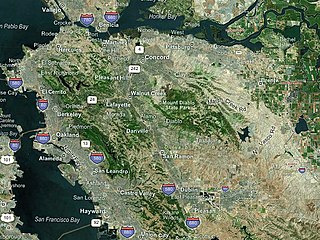
The East Bay is the eastern region of the San Francisco Bay Area and includes cities along the eastern shores of the San Francisco Bay and San Pablo Bay. The region has grown to include inland communities in Alameda and Contra Costa counties. With a population of roughly 2.5 million in 2010, it is the most populous subregion in the Bay Area.
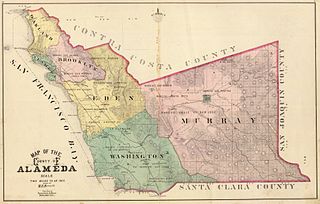
Washington Township is a former township of Alameda County, California in the San Francisco Bay Area region, which includes the present day cities of Union City, Fremont, and Newark. The first permanent settlement in the area was Mission San José, established in 1797. The township was formed in 1853, and named for president George Washington.

Eden Township is a former township of Alameda County, California in the San Francisco Bay Area region, which includes the present-day cities of Hayward and San Leandro, as well as the unincorporated census-designated areas of Ashland, Castro Valley, Cherryland, Fairview, and San Lorenzo. It was created from a group of Mexican land grants that were added to Alameda County when the county was established in 1853. Today there are several public and private agencies serving the region.

Alameda Terminal was a railroad station and ferry wharf at the foot and west of present-day Pacific Avenue and Main Street in Alameda, California, on the eastern shore of San Francisco Bay with ferry service to San Francisco. It was built in 1864 and operated by the San Francisco and Alameda Railroad. In 1869, it served as the original west coast terminus of the U.S. First transcontinental railroad, until the opening of Oakland Pier two months later. The western terminus was inaugurated September 6, 1869, when the first Western Pacific through train from Sacramento reached the shores of San Francisco Bay at Alameda Terminal, — thus completing the first transcontinental railroad "from the Missouri river to the Pacific ocean" in accordance with the Pacific Railroad Acts.

Emeryville station is an Amtrak station in Emeryville, California, United States. The station is served by the California Zephyr, Capitol Corridor, Coast Starlight, and San Joaquins. The station is the primary connection point for Amtrak Thruway buses serving San Francisco.
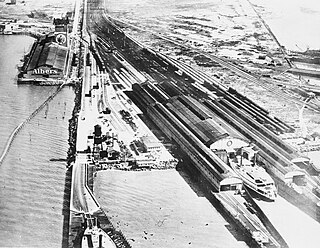
The Oakland Long Wharf was an 11,000-foot railroad wharf and ferry pier along the east shore of San Francisco Bay located at the foot of Seventh Street in West Oakland. The Oakland Long Wharf was built, beginning 1868, by the Central Pacific Railroad on what was previously Oakland Point. Beginning November 8, 1869, it served as the west coast terminus of the First transcontinental railroad. In the 1880s, Southern Pacific Railroad took over the CPRR, extending it and creating a new ferry terminal building with the official station name Oakland Pier. The entire structure became commonly and popularly called the Oakland Mole. Portions of the Wharf lasted until the 1960s. The site is now part of the facilities of the Port of Oakland, while passenger train service operates at the nearby Jack London Square/Dellums Station and another nearby station in Emeryville.
Thomas Edwin Caldecott was a pharmacist and politician. From 1923, Caldecott served in politics in Alameda County, California in the San Francisco Bay Area until 1951. The Caldecott Tunnel which is a key highway link through the Berkeley Hills is named after him.
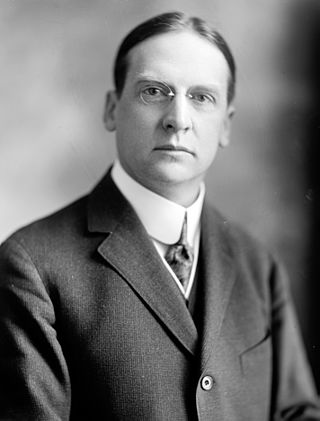
Joseph Russell Knowland was an American politician and newspaper publisher. He served as a member of the United States House of Representatives from California and was owner, editor and publisher of the Oakland Tribune. He was the father of United States Senator William F. Knowland.
Jingletown is a pocket arts community in Oakland, California, adjacent to the Oakland Estuary, and about two miles southeast of Lake Merritt. It is bounded by the Coast Guard Island Bridge and Fruitvale Bridges, which connect Oakland to the City of Alameda. It is part of the area called Fruitvale in East Oakland. Many working artists live in converted lofts that are common in the area.

San Francisco Bay in California has been served by ferries of all types for over 150 years. John Reed established a sailboat ferry service in 1826. Although the construction of the Golden Gate Bridge and the San Francisco–Oakland Bay Bridge led to the decline in the importance of most ferries, some are still in use today for both commuters and tourists.
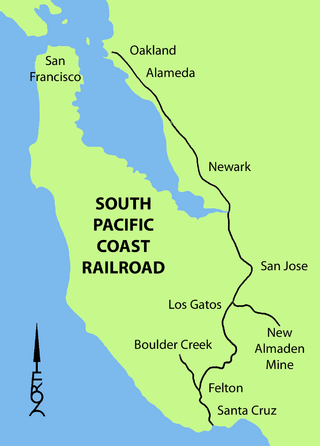
The South Pacific Coast Railroad (SPC) was a 3 ft narrow gauge steam railroad running between Santa Cruz, California and Alameda, with a ferry connection in Alameda to San Francisco. The railroad was created as the Santa Clara Valley Railroad, founded by local strawberry growers as a way to get their crops to market in San Francisco and provide an alternative to the Southern Pacific Railroad. In 1876, James Graham Fair, a Comstock Lode silver baron, bought the line and extended it into the Santa Cruz Mountains to capture the significant lumber traffic coming out of the redwood forests. The narrow-gauge line was originally laid with 52-pound-per-yard (26 kg/m) rail on 8-foot (2.44 m) redwood ties; and was later acquired by the Southern Pacific and converted to 4 ft 8+1⁄2 instandard gauge.
Zachariah "Zach" Montgomery was a publisher, lawyer, politician, and author, particularly known for his skills as an orator.

San Francisco Bay Ferry is a public transit passenger ferry service in the San Francisco Bay, administered by the San Francisco Bay Area Water Emergency Transportation Authority (WETA) and operated under contract by the privately owned, Blue and Gold Fleet. In 2022, the system had a ridership of 1,787,400, or about 10,400 per weekday as of the third quarter of 2023.

The Alameda Mole was a transit and transportation facility in Alameda, California for ferries landing in the East Bay of San Francisco from 1878 to the 1930s. It was located on the west end of Alameda, and later became part of the Alameda Naval Air Station. It was one of four neighboring moles. The others were the Oakland Mole, the WP Mole, and the Key System Mole. The purpose of the mole was to extend tracks of rail-based transportation lines beyond the shallow mud flats along the shore of the East Bay into water deep enough to accommodate the passenger and rail ferries to San Francisco.
The San Francisco and Alameda Railroad (SF&A) was a short-lived railroad company in the East Bay area of the San Francisco Bay Area. The railroad line opened 1864–1865 from Alameda Terminal on Alameda Island to Hayward, California, with ferry service between Alameda Terminal and San Francisco started in 1864. After being bankrupted by the 1868 Hayward earthquake, it was acquired by a subsidiary of the Central Pacific Railroad in August 1869. Part of the SF&A line between Alameda Terminal and San Leandro served as a portion of the First transcontinental railroad starting in September 1869, while the southern section was abandoned in 1873.
The Western Pacific Railroad (1862–1870) was formed in 1862 to build a railroad from Sacramento, California, to the San Francisco Bay, the westernmost portion of the First transcontinental railroad. After the completion of the railroad from Sacramento to Alameda Terminal on September 6, 1869, and then the Oakland Pier on November 8, 1869, which was the Pacific coast terminus of the transcontinental railroad, the Western Pacific Railroad was absorbed in 1870 into the Central Pacific Railroad.

The Southern Crossing is a proposed highway structure that would span San Francisco Bay in California, somewhere south of the San Francisco–Oakland Bay Bridge and north of the San Mateo–Hayward Bridge. Several proposals have been made since 1947, varying in design and specific location, but none of them have ever been implemented because of cost, environmental and other concerns.

Henry Alexander Melvin was an associate justice of the Supreme Court of California from September 28, 1908 to December 1920.
References
- ↑ "Planning for the Central Lower San Antonio Neighborhood" (PDF). Department of City and Regional Planning Institute of Urban and Regional Development, UC Berkeley. Archived from the original (PDF) on 28 February 2013. Retrieved 6 December 2016.
- ↑ "The centennial year book of Alameda County". Internet Archive. 1876. Retrieved 6 December 2016.
- 1 2 EARLY HISTORY WITH BIOGRAPHIES OF STATE OFFICERS. State of Michigan. 1888. pp. 407–.
- ↑ Jones, Dewitt (1934). Port of Oakland. The Board.
- 1 2 D.W.ENSIGN & CO. (1880). BERRIEN AND VAN BUREN COUNTIES. pp. 334–.
- ↑ Michigan. Department of State (1887). Michigan Official Directory and Legislative Manual. State of Michigan. pp. 215–.
- ↑ Michigan Historical Commission; Bingham, Stephen D. (1924). Michigan Biographies: Including Members of Congress, Elective State Officers, Justices of the Supreme Court, Members of the Michigan Legislature, Board of Regents of the University of Michigan, State Board of Agriculture and State Board of Education. Michigan Historical Commission.
- ↑ Vigil, Lauren Hennel (3 February 2016). "The Real Brooklyn by the Bay". East Bay Express. Retrieved 6 December 2016.
- ↑ Bancroft, Hubert Howe (1888). History of California. History Company. pp. 478–.
- ↑ Harlan, Jacob Wright (18 May 2016). Growing Up with California: 1846~1888. BIG BYTE BOOKS. pp. 103–.
- ↑ Lewis Publishing (1968). A Memorial and Biographical History of Northern California, Illustrated. Рипол Классик. pp. 100–. ISBN 978-5-87375-797-8.
- ↑ The Bay of San Francisco: The Metropolis of the Pacific Coast and Its Suburban Cities : a History. Lewis Publishing Company. 1892. pp. 386–.
- ↑ MacMullen, Jerry (1 January 1944). Paddle-wheel Days in California. Stanford University Press. pp. 127–. ISBN 978-0-8047-0382-6.
- ↑ History of Alameda County, California: Including Its Geology, Topography, Soil, and Productions. M. W. Wood. 1883. pp. 545–.
- ↑ "Minturn v. Larue". Justia. Retrieved 6 December 2016.
- ↑ "The centennial year book of Alameda County, California". Internet archive. 1876. Retrieved 6 December 2016.